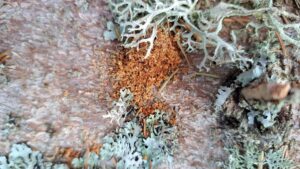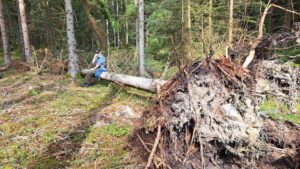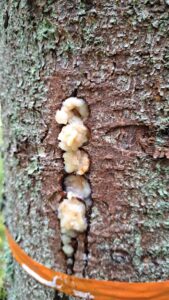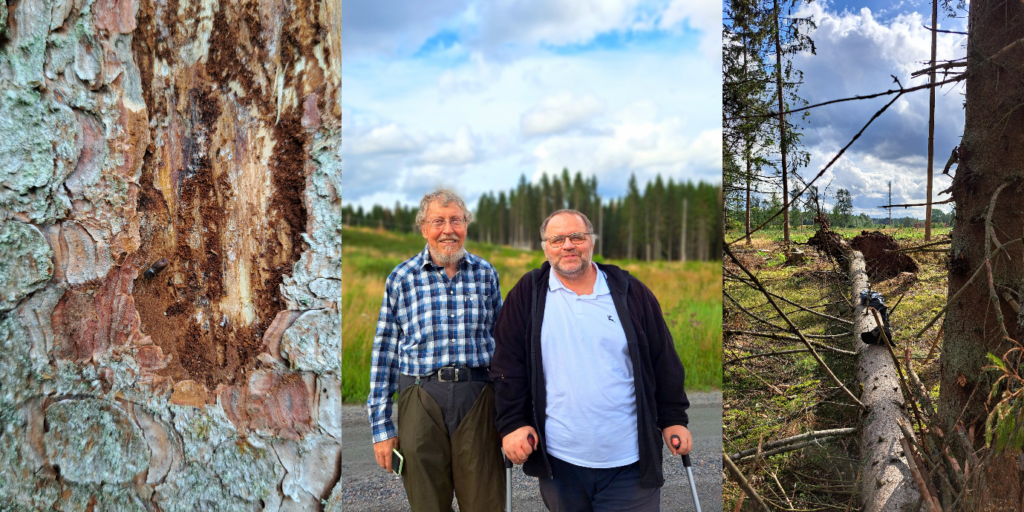August 11th, 2024, Skara, Sweden – The RESDINET project team from the Institute of Forest Ecology (IFE SAS) completed a crucial phase of their ongoing research in the bark beetle-affected spruce forests near Skara, Sweden. This fieldwork, supported by insights from renowned experts, marks a significant step in the multi-year effort to study and mitigate the impact of bark beetles through early detection methods using spectral signatures.
Our Slovak research team, part of the RESDINET project, embarked on an important fieldwork mission in Sweden this summer, continuing our efforts to understand and combat the devastation caused by bark beetles in spruce forests. The journey began with a flight from Prague to Copenhagen, followed by a drive to Lund, and finally reaching the study sites near Skara Remningstorp. These sites are key locations in the ongoing research in Sweden to develop early detection systems for bark beetle attacks using advanced drone-based hyperspectral imaging.
This year’s fieldwork built upon the multi-year drone campaigns organized and led by Dr. Langning Huo and Assoc. Prof. Henrik Persson from the Swedish University of Agricultural Sciences (SLU). The drone campaigns provided valuable insights into the spectral signatures of trees under bark beetle stress. The focus of the current mission was to install dendrometers and sapflow meters on selected trees, aiming to monitor their physiological responses in real-time. In April 2024, the Slovak team strategically placed these instruments on trees located at both the forest edge and the interior, as well as on trees with varying crown lengths—those with long versus short crowns.
In addition to the installation of monitoring devices, the Slovak team also conducted extensive sampling for genetic and chemical analyses. These samples are critical for understanding the underlying mechanisms of tree resistance and susceptibility to bark beetle attacks. The research aims to identify specific genetic markers and chemical profiles that could indicate early stages of infestation, potentially leading to more effective management strategies in the future.
Upon returning to the sites in August 2024, the team conducted a thorough check of the tree statuses. Out of over 70 experimental trees, only two were found to have been attacked by bark beetles. Both of these trees exhibited very little or no resin flow—a key defence mechanism in spruce trees. In contrast, the unaffected trees showed intense resin flow, which not only acts as a physical barrier by pitching out the beetles but also has anti-fungal and anti-feeding properties. This finding reinforces the importance of maintaining tree health and hydration, as adequate water supply is crucial for effective resin exudation.
Unfortunately, two trees with dendrometers were lost to windfall and were subsequently attacked by bark beetles. This occurrence highlights the dynamic challenges faced in field research, where natural elements such as wind can influence the outcomes of experiments.
A significant highlight of this fieldwork was the support and collaboration with Prof. Fredrik Schlyter, a world-renowned professor in chemical ecology. Prof. Schlyter assisted the team in the field and hosted scientific discussions at the Department of Chemical Ecology at SLU. These discussions with Prof. Schlyter and his former colleagues opened new, interesting ideas and prospects for future research and collaborations. The insights gained from these exchanges are expected to influence and enhance the direction of the RESDINET project, potentially leading to breakthroughs in our understanding of spruce tree resilience against bark beetle infestations.
The RESDINET project’s ongoing work in Sweden is critical for developing strategies to manage and mitigate the impact of bark beetles, especially in the context of a changing climate. The insights gained from this fieldwork will contribute to the broader understanding of spruce tree resilience and could pave the way for more effective early detection systems, helping forest managers protect these vital ecosystems.
The mutual coordinated efforts of the Slovak, Swedish and Finnish teams within the RESDINET project continue to advance the frontiers of forest ecology, offering hope for the sustainable management of forests in the face of ongoing environmental challenges.
Stay connected: For more scientific updates and news, follow RESDiNET on social media:
- Instagram: @resdinet
- Facebook: www.facebook.com/resdinet
- YouTube: @resdinet
- X: DE_Research_
Visit our website and subscribe to our newsletter for regular updates on our research and projects.







